
Chapter V:
Aviation Logistics
Since 1965, the Army Aviation Program has experienced an unprecedented and unprogrammed acceleration of aircraft production, deployments, and utilization. During this time, it was frequently necessary to support the program with inventories of repair parts, components, and engines that in pre-Vietnam war years would have been thought completely inadequate. At the same time aviation operating and support units in the field reached and maintained levels of operational readiness and flying hour rates that many believed were beyond reach with the "state-of-the-art" helicopters deployed to Southeast Asia. In order to meet operating requirements, it was necessary to improvise, innovate and in some cases revolutionize logistic support systems. As so often happens with emergency improvisations, when they work they become part of the system and yesterday's emergency often becomes tomorrow's norm.
From a relatively evenly balanced inventory of fixed wing and rotary wing aircraft in fiscal year 1960 (totaling some 5,528 aircraft) the Army has progressed to over 12,000 aircraft in 1970, most being rotary wing. The acquisition value of the inventory, which in fiscal year 1960 totaled $600 million, increased five times during this period. (Chart 4) The dollar value of secondary items required to support the aircraft fleet increased from $261.4 million to $2.2 billion, or eight times, as compared to the fivefold increase for the end item inventory. (Chart 5)
Chart 6 outlines fiscal year 1961-1970 Army aviation funded programs. The Procurement of Equipment and Missiles progression was significant during the 1966-1968 time frame. During this period the Army was procuring and deploying large numbers of aircraft and Procurement of Equipment and Missiles secondary items for support of increased inventories and flying hours. The latter were essentially "Life of Type Subsystems." After the initial procurement, requirements were met from overhaul programs.
Repair parts for Army aviation have been provided for in the Army Stock Fund since 1963. However, prior to that time air-
[134]
CHART 4 - ARMY AIRCRAFT INVENTORY AND VALUE FISCAL YEAR 1960-1970

CHART 5 - SECONDARY ITEM INVENTORY REQUIRED TO SUPPORT THE AIRCRAFT FLEET
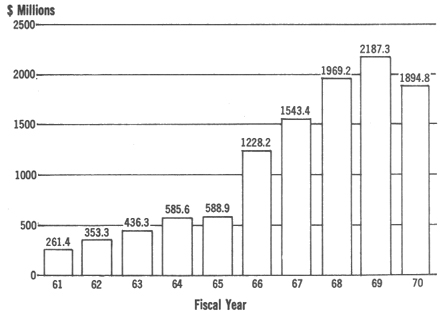
craft repair parts were purchased with Operation Maintenance Army funds. Since the inclusion of aircraft repair parts in the Army Stock Fund, the Operation Maintenance Army account has
[135]
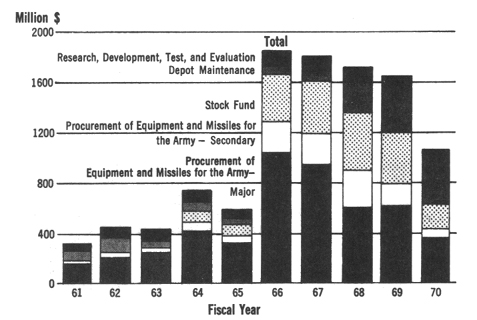
provided only those dollars required to overhaul aircraft engines, components,
and associated equipment (avionics, armament systems, and so forth) at depot
level. The amount funded for Research, Development, Test, and Evaluation remained
relatively stable. The total funding program for Army aviation reached a high
of $1.8 billion in fiscal year 1966.
Chart 7 shows the percent of total Army funds spent on aircraft during the period 1969-1971. A major problem was caused by rapidly changing requirements for particular aircraft, both increases and decreases. Table 7 shows the monthly UH-1 production
TABLE 7-UH-1 PRODUCTION SCHEDULE
| Month | 1965 | 1960 | 1967 | 1968 | 1969 | 1970 |
|---|---|---|---|---|---|---|
| Jan | 57 | 74 | 150 | 85 | 73 | 100 |
| Feb | 58 | 81 | 150 | 82 | 82 | 100 |
| Mar | 58 | 87 | 155 | 80 | 89 | 94 |
| Apr | 60 | 93 | 152 | 85 | 100 | 74 |
| May | 63 | 99 | 150 | 80 | 100 | 73 |
| Jun | 66 | 100 | 143 | 66 | 44 | 74 |
| Jul | 68 | 102 | 139 | 65 | 100 | 71 |
| Aug | 67 | 114 | 120 | 65 | 101 | 67 |
| Sep | 70 | 109 | 110 | 65 | 101 | 67 |
| Oct | 71 | 125 | 106 | 65 | 101 | 64 |
| Nov | 74 | 133 | 98 | 65 | 101 | 66 |
| Dec | 75 | 142 | 85 | 53 | 101 | 67 |
[136]
CHART 7 - PERCENT OF ALLOCATED ARMY FUNDS SPENT
ON AIRCRAFT
FISCAL YEAR 1969-1971
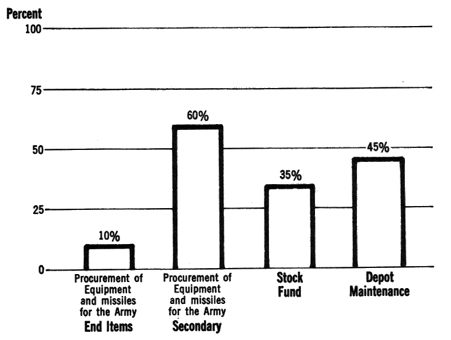
schedule since 1965, which is illustrative of the general turbulence that was experienced.
Airframes have a relatively easily identifiable basis of issue, and requirements and assets can readily be computed. A major difficulty, and one which resulted in problems and shortages throughout the period was the determination of requirements for ancillary equipment such as avionics, armament and ammunition, tools, and test equipment.
From an austere beginning when two helicopter companies arrived in Vietnam on 11 December 1961, the total number of U.S. Army aircraft increased to 510 by 1 January 1965 and then further increased to a peak of 4,228 by September 1969. When the buildup commenced in 1965, the U.S. Army Support Command Vietnam had one aircraft maintenance and supply battalion (765th Transportation Battalion) to provide backup direct and general support for all Army aircraft in-country. This battalion was located at Vung Tau and consisted of direct support companies and one general support company. The three direct support companies were located at Vung Tau, Saigon, and Nha Trang. They provided back-
[137]
up support for separate aviation companies having their own organic or attached direct support and they provided direct support for small aviation detachments that lacked this capability.
The one general support company was located with the battalion headquarters at Vung Tau. An aviation supply point in Saigon, operated by the aviation detachment of U.S. Army Support Command Vietnam, - provided aviation-peculiar supplies for all Army aircraft in Vietnam.
In 1965 the Commanding General, U.S. Army Support Command Vietnam established a committee to devise a plan to support a large influx of Army aircraft. Basic criteria for the plan were that it should provide for one-stop supply and maintenance service, and provide for an expansion of this service commensurate with increases in aircraft densities. Consideration of the operational structure to be supported led to the development of plans for three prime alternative organizations. These were as follows:
1. Aircraft supply and maintenance units integrated in an aviation brigade, which was planned as a control element for all non-divisional aviation activities.
2. Aircraft supply and maintenance units integrated in the 1st Logistical Command, which had been recently activated.
3. A separate headquarters commanding all non-divisional aircraft supply and maintenance units, assigned to the Aviation Brigade, assigned to the 1st Logistical Command, or a separate command under U.S. Army Vietnam.
The decision reached was to establish a separate headquarters under the direct command of U.S. Army Vietnam. This basic organizational structure has operated throughout the Vietnam Era with only one minor variation. Originally, the command was under the staff supervision of the U.S. Army Vietnam G-4. In October 1967, staff supervision was changed to the U.S. Army Vietnam Aviation Officer.
Following the September 1965 decision to establish a separate command, the next two months were spent in developing an organizational structure and preparing the necessary authorization documents. In November 1965, a group headquarters was established on a provisional basis and finally, on 17 January 1966, a U.S. Army Pacific General Order was published activating the 34th General Support Group.
As previously stated, the total Army aircraft density increased to a high of 4,228 in September 1969. The deployed aircraft were assigned to a total of 142 company-sized units plus a number of miscellaneous smaller detachments. Of the 142 companies, 63 were
[138]
organic to division, brigades, or squadrons and had their own organic direct support supply and maintenance capability. The remaining company-sized units were supported by cellular direct support detachments. The 34th General Support Group provided backup support to these company sized units as well as direct support and general support for all aviation activities in U.S. Army Vietnam.
The 34th General Support Group as displayed in Map 3, ultimately had 2 depot companies, 5 general support companies, 11 direct support companies, 4 aviation electronics companies, and the Aviation Materiel Management Center with which to accomplish its mission.
Qualitative personnel problems in supply and maintenance were particularly critical for aircraft because of the nature of the materiel maintained. Civilian contractors were used to augment the military capability in critical skill areas, particularly in the areas of sheet metal and structural repairs. Table 8 shows strength authorizations by fiscal year for contractor personnel.
| Company | FY 65 | FY 66 | FY 67 | FY 68 | FY 69 | FY 70 |
|---|---|---|---|---|---|---|
| Lockheed | - | - | - | 100 | 232 | 287 |
| Lear Siegler | - | - | 457 | 624 | 832 | 733 |
| Dynalectron | 34 | 239 | 550 | 847 | 1056 | 872 |
| TOTAL | 34 | 239 | 1007 | 1571 | 2120 | 1892 |
The Aviation Systems Command provided either Department of the Army civilians or manufacturer's field service representatives to advise and assist in problem areas arising from the operation of complex and sophisticated equipment in the field. In the summer of 1969, 151 field service representatives were authorized. These field service representatives were in addition to the new equipment training teams sent into Vietnam upon introduction of a new equipment item. Project COUNTER team, discussed in another section, were also provided to the 34th General Support Group.
This augmentation with contract labor and the employment of field service representatives and other teams to provide instruction was necessitated, to a large degree, by the fact that there was not an adequate military rotational base in Continental U.S. from which to draw upon for such critical skills as sheet metal and structural repair workers. Because of Vietnam priorities, nearly
[139]

[140]
all first line Army aircraft were located in Vietnam. This further reduced the military experience base. Also, as in the electronics area, trained aircraft maintenance personnel were highly susceptible to incursions from industry, making retention in the Service difficult.
Facilities problems associated with the support of Army aircraft were largely related to the development of storage and maintenance facilities. Overall operation of the system was not significantly affected by port and Line of Communications limitations.
Some deterioration of packaging and damage to supplies occurred as a result of delays in expanding storage facilities at Saigon, but the impact was not comparable to that in the general supply depots.
Construction of aircraft maintenance facilities presented more serious problems because of the sensitivity of aircraft components to the elements. Maintenance tents provided as organizational equipment were not only short-lived in the tropical climate and expensive to replace, but generally were too small for the volume of work, resulting in a significant loss of valuable man-hours. These man-hours were consumed in moving aircraft in and out. In addition, shop vans proved too small to handle sheet metal work on bulky cowling and also for balancing blades. Construction of permanent facilities to offset these problems proved time consuming. For example, the 604th Direct Support Company moved into Pleiku in March 1966, and an adequate hangar facility for them was not completed until the summer of 1969. Although available statistics are inadequate to allow precise measurement, the weight of evidence indicated that a lack of adequate maintenance facilities appreciably degraded the efficiency of maintenance operations.
During 1965, aircraft repair parts were provided by the aircraft supply point at Tan Son Nhut. This supply point was operated by personnel of the U.S. Army Support Command, Vietnam Aviation Detachment and augmented by the supply platoon of the 330th General Support Company and about 70 local national employees. All requisitions from operating units, general and direct support companies, other Services, and free world forces were submitted directly to the supply point which provided a retail
[141]
service. Items not available within the 8,000 item Authorized Stockage List were requisitioned from Okinawa. At Okinawa the requisitions were filled if the items were available. However, if they were not available the requisitions were passed through U.S. Army Pacific to the appropriate Continental U.S. National Inventory Control Point. Chart 8 shows this requisition and supply flow.
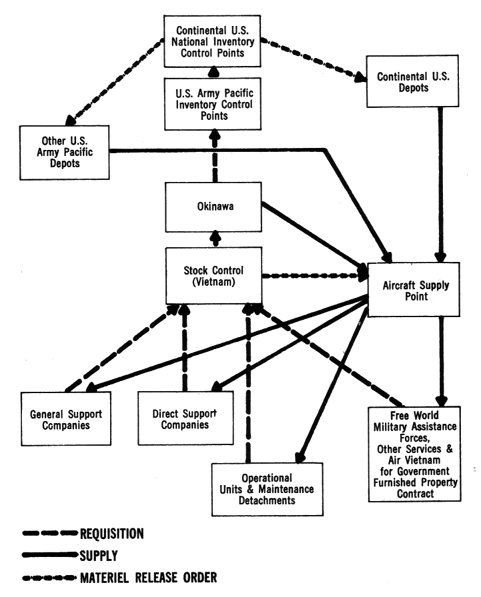
[142]
Following activation of the 34th General Support Group, several changes were made in the basic supply system. Chart 9 shows the requisition and supply flow beginning in April 1966. Major changes included the following:
CHART 9-REQUISITION AND SUPPLY FLOW, APRIL 1966 TO APRIL 1968
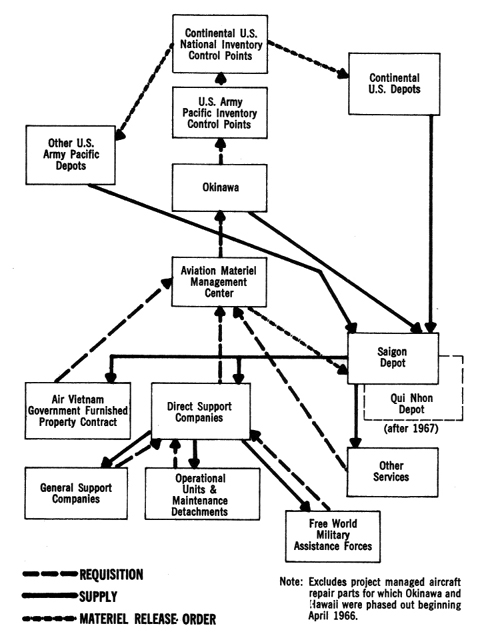
[143]
Establishment of the Aviation Materiel Management Center using resources of the 58th Transportation Battalion. Resources of this battalion continued to be used for this purpose until February 1968 when an Aviation Materiel Management Center Table of Distribution was approved and the 58th was assigned to I Corps. The Aviation Materiel Management Center served as an inventory control center for all aviation materiel and provided centralized accountability for all depot stocks. Inventory control was converted from a manual operation to the use of an IBM 407 Electronic Accounting Machine in early 1966, to a UNIVAC 1005 at the end of 1966, to an IBM 1460 in March 1968, and to an IBM 360/50 in mid-1969.
In April 1966, the Saigon Aviation Depot was removed from retail operations. After this, all requisitions passed through direct support companies except those for the U. S. Air Force and Air Vietnam. Beginning in late 1966 direct support companies were equipped with NCR 500 equipment to enable them to furnish data and interface with Aviation Materiel Management Center.
An increased density of aircraft supported, together with increasing delays in obtaining supplies through the Okinawa U.S. Army Pacific route, resulted in the third major change in the supply system. (Chart 10) Beginning in July 1966, Okinawa and Hawaii were bypassed for all aircraft parts. This introduced the stovepipe system whereby Aviation Materiel Management Center passed all requisitions directly to the Aviation Systems Command in St. Louis, with only an information copy to U.S. Army Pacific for billing purposes. In addition to a reduction in a high-dollar pipeline, this stovepipe system (Weapons System Requisitioning) greatly improved communications between the consumer in Vietnam and the National Inventory Control Point in the Continental U.S.
In September 1969, weapons systems requisitioning procedures were further modified. Techniques were introduced to permit Aviation Materiel Management Center requisitions for aviation items to be routed through the Defense Automatic Addressing System with an image copy of all transactions being passed to the Aviation Systems Command. A weapons system project code and the Aviation Systems Command distribution code were used to identify aviation item traffic. With minor variation, this procedure is being standardized for use by all Army weapons systems worldwide.
Overall, the aviation repair parts system has been effective and responsive as was indicated by the low percentage of aircraft in the
[144]
not operationally ready supply category (a 5.2 percent rate as of 31 December 1970 compared with a standard of 7 percent) and a demand satisfaction rate consistently around 65 percent. From an authorized stockage list of 8,000 lines in 1965, stockage increased to a high of 46,000 lines late in 1968.
CHART 10-REQUISITION AND SUPPLY FLOW, APRIL 1968 TO SEPTEMBER 1969
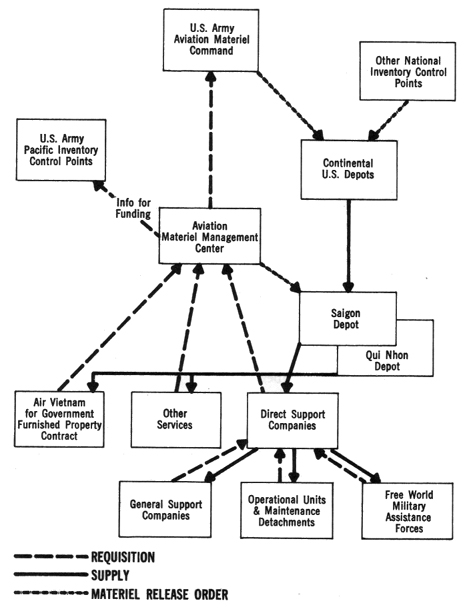
[145]
In line with the objectives of the Logistics Offensive, they were subsequently reduced to 25,495 lines by December 1970 without adverse effect on supply effectiveness.
There was some item duplication in stockage lists of the Aviation Materiel Management Center and the 1st Logistical Command. The items were primarily industrial bulk materiel items used in repair operations and certain items of common hardware. The value of providing aviation units with a single point for obtaining aircraft repair parts outweighed the cost of multiple stockage.
In April 1966, the Army deployed a Floating Aircraft Maintenance Facility to Vietnam. This was the USNS Corpus Christi Bay. This ship had been converted from a seaplane tender at the Navy yard in Charleston, S.C. in 1965. The Floating Aircraft Maintenance Facility was designed for use in contingency operations, initially for backup direct support and general support and provided a limited depot capability for the repair of aircraft components. It was equipped to manufacture small machine parts and also to repair items requiring extensive test equipment operating in a sterile environment such as avionics, instruments, carburators, fuel controls, and hydraulic pumps. The mobility offered by the ship also contributed to the effectiveness of aircraft support since it could move from one deep water port to another as the density of aircraft units shifted with changing tactical situations.
Through the return of components to a serviceable condition, the issuance of parts from its shop stock in direct response to user requests, and the fabrication of hard-to-get repair parts, the Floating Aircraft Maintenance Facility was responsible for removing a substantial number of aircraft from a not operationally ready supply condition.
Prior to Vietnam, it was believed that an overseas pipeline of 13 months would be required for aircraft engines (8 months for engines at wholesale level in Continental U.S. depot stocks and overhaul facilities plus 5 months in transit and in stock overseas) . One month of pipeline is the equivalent of the number of unserviceable engines generated in 30 days. At the peak of operations, each day of pipeline was worth $1.16 million, while 13 months would require spare engines in the value of $452.4 million.
Through intensive management and the use of air transporta-
[146]
tion, actions were taken to reduce the pipeline time first to 91/ months, then 8 months, 7 months, and by December 1970 to 61/2 months. Some of the methods and techniques used to keep the aviation inventory in motion included better asset visibility and control, weapons system management, closed loop/direct exchange, and retrograde control.
Early in 1967, a reporting system was established to account for worldwide assets of the T53 and T55 gas turbine engines. This system, known as the Aircraft Component Intensive Management System, provided a postcard report to the Aviation Systems Command for each engine by serial number and gave every change in condition, location, or status, whether the engine was installed or was a spare. The reporting system later was broadened to cover 45 Aviation items including both engines and components representing a value of $1.3 billion.
For critical and high-value items required for Vietnam, Aviation Systems Command established a system known as Aircraft Intensively Managed Items. This system, which in March 1971 included 227 items and extended worldwide, required that a forecast of monthly requirements be submitted to Aviation Systems Command each quarter. The customers and Aviation Systems Command met and "negotiated" monthly levels. Levels were based upon forecasts of consumption (replacement) with minimal safety levels to preclude running out of stock. The customer requisitioned once a month, and Aviation Systems Command shipped the items by air to arrive in-country 15 days in advance of the month in which required.
By May 1968 partly as a result of the Tet Offensive the requirement for T53 engines for Huey and Cobra helicopters and T55 engines for the Chinook helicopter (CH-47) increased greatly. Since production and overhaul programs were behind schedule, a major problem developed. The only way to meet this problem was to reduce the pipeline further. Elements in the pipeline with the potential for providing an early response were the intransit time, and the in-country unserviceable engines. Accordingly, a combined ground and air transportation system was established. All new or overhauled T53 and T55 engines were accumulated at the Army Aeronautical Depot Maintenance Center, Corpus Christi, Texas, for direct air shipment to the Republic of Vietnam three times a week by special mission aircraft. At the same time, unserviceable engines authorized for repair in Vietnam were reduced to those that could be repaired in 15 days; the remaining unserviceable engines were returned for repair to the Continental U.S.
[147]
by the special mission aircraft. This system flushed out large quantities of unserviceable engines, reduced transportation costs, and provided a closed loop/direct exchange program with U.S. Army Vietnam. This program was so effective that since early June 1968 there were no not operationally ready supply problems for these engines in spite of the reduced pipeline.
The first Aviation Closed Loop Support Conference was held at Headquarters U.S. Army Pacific in March 1967. Through 1970, nine Aviation Closed Loop Conferences were held. Initially Closed Loop Support was limited to U.S. Army Vietnam, but as aircraft became available for other commands the program was expanded worldwide. In addition to providing a means of controlling the distribution of assets and providing visibility of equipment returning to Continental U.S. for overhaul, the Closed Loop Support program provided a forum for presenting and resolving problems in aviation logistics operations worldwide.
From September 1969 to June 1970, the Army was confronted with a large backlog of unserviceable first line aircraft consisting principally of the UH-1, AH-1G, CH-47 and OH-6. This situation not only denied aircraft to army units in the field, but also placed the Army in the position of needing to buy new aircraft while having a backlog of unserviceable aircraft on hand. A critical analysis was made of the mandatory time between overhauls for aircraft; and based on Vietnam experience during the previous year (when 85 percent of all hightime Hueys returned to Continental U.S. averaged 2,140 hours) , it was agreed by Closed Loop Support conferees that the Huey (UH-1) Time Between Overhauls could be increased from 2200 hours to 3300 hours. Appropriate increases in Time Between Overhauls were also made for other aircraft. In this manner, aircraft utilization was increased by delaying returns to Continental U.S. For overhaul. Transportation and depot maintenance requirements were reduced, increasing the number of serviceable aircraft in the inventory at the least cost. This life extension program was carefully monitored to preclude any adverse impact on safety-of-flight or materiel readiness.
Also during the September 1969 Closed Loop Support Conference, attendees evaluated the requirement for modifying the CH-47C helicopters (equipped with the T55-1-7C engine) to a full "C" configuration with the -11 engine. This requirement included 27 separate modifications and required approximately 3,500 manhours to accomplish. During the Closed Loop Support
[148]
conference, it was determined that the work could be done by Air Vietnam at less cost and in less time than if the helicopters were returned to the U.S. In January 1970, the modification effort began with Air Vietnam performing the work. This program required approximately two years at a cost of about $2.6 million versus an estimated $10.2 million, if the aircraft had been returned to the Continental U.S. Also the aircraft were out of action for only 90 days rather than the 150 days that would have been required, if the work had been done in the Continental U.S.
Prior to the March 1970 Closed Loop Support conference, it had been planned to deploy 23 CH-54B's, the modified "Flying Crane," to U.S. Army Vietnam. However, after consultation with the U.S. Army Vietnam representative, and recognizing the potential phaseout of "Flying Cranes" in the next 18 months, it was agreed that such a transfer would be costly and was unnecessary since the CH-54A's in U.S. Army Vietnam were accomplishing the required mission in a satisfactory manner. Accordingly, the CH-54A's were retained in U.S. Army Vietnam, except for those hightime and crash-damaged aircraft that had to be returned. The CH-54B's were assigned elsewhere in the Army. This program reduced both transportation and depot maintenance overhaul costs that would have been incurred, if the CH54A's had been returned to the Continental U.S.
For aviation it was found practicable and in many cases more economical to ship by air nearly all aircraft support including the aircraft as well as the supporting repair parts, components and engines.
Three separate concepts of direct support aircraft maintenance were employed in Vietnam. The infantry divisions centralized the aircraft direct support capability in the aircraft maintenance company of the maintenance battalion; the airmobile divisions centralized the capability in the transportation aircraft maintenance battalion; and the 1st Aviation Brigade company-sized units were authorized an attached direct support aircraft maintenance detachment.
Through the extensive operational experience in Vietnam it was found that conventional organizational maintenance organizations supported by centralized direct support units did not provide the desired level of availability to meet tactical requirements. As a result various methods of maintenance support were tried in an attempt to increase readiness. The concept employed by
[149]
the 1st Aviation Brigade was found to provide 10 percent higher readiness with 12 percent higher utilization when compared with units not having a direct support capability. In February 1968, as a result of an analysis made by Deputy Chief of Staff for Logistics the Chief of Staff approved the concept of integrating the direct support detachments into the aviation companies of the 1st Aviation Brigade. U.S. Army Vietnam was also requested to apply the concept to the infantry and airmobile division.
Within the 1st Cavalry Division and the 101st Airborne Division a combined total of nineteen detachments were organized, utilizing the resources of two of the divisions' four direct support aircraft maintenance companies. The detachments were initially attached to the aviation units with an objective of integrating them at a later date if the concept proved to be practicable.
A test was conducted in the 9th Infantry Division to determine the feasibility of adopting the decentralized direct support concept to all infantry divisions. Although this was highly successful in improving aircraft operational readiness rates, agreement could not be reached on additional personnel requirements for the decentralized organizations.
The major aspect of the integrated system was that both organizational and direct support maintenance became the responsibility of a single commander. This responsibility permitted the commander to accomplish all functions associated with scheduled maintenance to include component replacement and minor battle damage repair. The increased organic maintenance capability for aviation units permitted the units to schedule maintenance according to their operational requirements, without an unacceptable degradation of tactical deployment capability. Backup direct support maintenance units were still required to take care of extensive crash damage repairs; operational readiness float support; and repair parts storage, receipt and issue requirements.
The Aircraft Readiness, Utilization, and Loss Reporting Systems
The reporting system and techniques employed to monitor aircraft readiness, utilization, and losses have undergone several major revisions since 1960. Changes were made to improve the accuracy, timeliness, and scope of information collected in order to have greater visibility over aviation inventories and to promptly highlight logistic support problems.
Initially the Army's reporting system included three major categories. These were (1) aircraft inventory, (2) flying hours, and (3) days in commission. It provided for the monthly reporting
[150]
of worldwide army aircraft by serial number, unit assignment, flying hours accomplished during the month, and the operational readiness rate (which was variously known as aircraft in commission or aircraft available) . Readiness data were compiled on the basis of the total number of days in commission and out of commission during the month reported and the reasons (that is supply, maintenance, other) for being out of commission. The number of days in commission for four plus hours was counted as being operationally ready for the 24-hour period. Conversely, aircraft out of commission for more than four hours were reported as being not operationally ready during the entire day and the downtime was charged to supply, maintenance, or other. Reporting criteria allowed a wide range of interpretation and there were no aircraft readiness standards showing the degree of readiness to be maintained.
In 1962 a supply bulletin, "Army Aircraft Maintenance Man-hour Factors and Availability Norms," was published. It provided the factors and formulas needed to compute aircraft maintenance manpower requirements. It also gave guides to be used as a yardstick in measuring aircraft availability rates. This supply bulletin was not directive in nature but was widely used as containing the best data available. Readiness standards placed little demand on the commands, permitting down times for supply in excess of 10 percent and an average maintenance down time for the fleet as high as 26 percent. Because of the low standards, there was little emphasis in the field or in the logistics system for improving aircraft readiness.
In early 1963 Department of the Army Project 35, "Availability and Downtime Rates for Army Aircraft," was established. Project 35 had as its objectives to establish and maintain realistic worldwide aircraft availability standards; to assure that aircraft readiness was compatible with mission requirements and priority of assignment; and to provide to the Department of the Army information on the maximum potential use of its aircraft consistent with manning, materiel and money. All major commands and Department of the Army staff agencies were represented. Separate standards were set for aircraft with significant differences in mission requirements and logistic support capabilities; for example, the UH-1A in the training base versus UH-1 elsewhere. While Project 35 was getting underway, the Office of the Secretary of Defense had established a working group to develop a uniform equipment readiness reporting system. This resulted in Department of Defense Instruction 7700.5, which became effective in January 1964.
[151]
This Instruction prescribed standard readiness definitions: operational ready, not operational ready-supply, and not operational ready-maintenance. The services were directed to establish standards and to report aircraft readiness and down time to the nearest hour in a 24-hour day. Department of the Army Project 35 was well on the way to accomplishing all these things, and in January 1964 a new army regulation (AR 710-12) was published implementing the Department of Defense Instruction.
The Army's application of the Office of the Secretary of Defense system retained reporting aircraft utilization (flying hours) . Later changes added reporting of the time accumulated on installed gas turbine engines by serial number. This information has proved extremely valuable in forecasting engine replacement requirements. Loss reporting is also included in the Army's reporting system.
Chart 11 shows helicopter readiness rates of U.S. Army Vietnam for the period fiscal year 1965 until the 1st half of fiscal year 1971. A sharp decline in fiscal year 1965 was attributed to buildup activities. Inventories of helicopters in U.S. Army Vietnam increased more than ten times during the period and a readiness rate in excess of 70 percent was maintained despite the fact that these aircraft had to fly in excess of the programmed hours. In May 1970, following a Project 35 Committee review, U.S. Army Vietnam standards were adjusted upward because
CHART 11-OPERATIONAL READINESS OF U.S. ARMY VIETNAM ROTARY WING AIRCRAFT
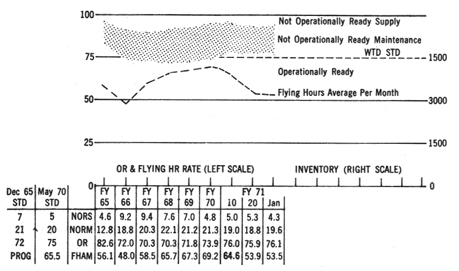
[152]
experience showed that logistic support operations permitted the attainment of higher goals. The new goals decreased Not Operational Ready-Supply from 7 percent to 5 percent and Not Operational Ready-Maintenance from 21 percent to 20 percent. Despite the aging of the fleet and the high utilization rates, these new standards were met.
Significant to operations in Vietnam was the use of helicopters in the logistic support role. Their use freed the Army from a complete dependence on surface transportation. The helicopter became an indispensible link in the forward area of operation because of its ability to operate in virtually any weather condition, day or night, with little or no preparation of landing sites.
The majority of the logistic missions were carried out by UH-1, CH-47, and CH-54 aircraft. The UH-1's and CH-47s were primarily to support the forward areas and delivered such diverse types of cargo as hot food, medical supplies, ammunition, consumable supplies, and repair parts.
The UH-1's operated forward to the platoon level, while the CH-47's transported heavier and more bulky loads to battalions and companies. The CH-54's were primarily employed to lift larger items of equipment to otherwise inaccessible locations and for evacuation of heavy lifts from the combat area to the support area. Extensive use was made of the external sling load concept. This required only the time to fasten the load to a cargo hook suspended beneath the aircraft. By employing the sling load technique, it was not uncommon for the CH-47 to airlift 100 tons of supplies a day within a 10 mile radius. The significance of the helicopter role in combat support is further substantiated by data shown in Table 9.
In addition to the daily combat service support and resupply missions, the larger helicopters, the CH-47 and CH-54, ,developed a major capability in the recovery of other aircraft, vehicles and equipment requiring removal to the rear. Through extensive experience, procedures were developed whereby aircraft and other equipment and materiel could be rigged for pick-up by helicopters in a matter of minutes, even in enemy territory under fire. To date, helicopters have accounted for the recovery of over 10,000 aircraft, belonging to all of the services, valued in excess of $2.5 billion.
[153]
TABLE 9- INTRA-VIETNAM CARGO MOVEMENT BY AIR, 1967-1969
| Month | 1967 | 1968 | 1969 | Monthly Total | ||||
|---|---|---|---|---|---|---|---|---|
| Common Service Airlift System | Helicopters | Common Service Airlift System | Helicopters | Common Service Airlift System | Helicopters | Common Service Airlift System | Helicopters | |
| Jan | 59,000 | 40,000 | 78,721 | 82,602 | 78,250 | 98,968 | 215,971 | 221,570 |
| Feb | 55,000 | 41,000 | 75,012 | 77,362 | 70,727 | 95,356 | 200,739 | 213,718 |
| Mar | 65,000 | 50,000 | 92,483 | 80,750 | 73,086 | 120,697 | 230,569 | 251,447 |
| Apr | 65,400 | 55,000 | 88,948 | 94,387 | 69,382 | 110,353 | 223,730 | 259,740 |
| May | 64,700 | 66,000 | 85,374 | 98,181 | 69,209 | 111,822 | 219,283 | 276,003 |
| June | 64,800 | 60,500 | 83,967 | 108,176 | 58,620 | 114,407 | 207,387 | 283,083 |
| July | 64,700 | 65,000 | 82,937 | 110,800 | 57,026 | 103,479 | 204,663 | 279,288 |
| Aug | 65,000 | 81,000 | 80,945 | 97,546 | 61,311 | 111,342 | 207,256 | 289,888 |
| Sep | 64,700 | 81,500 | 81,703 | 91,421 | 61,686 | 110,564 | 208,089 | 283,485 |
| Oct | 74,800 | 106,000 | 81,723 | 87,322 | 62,923 | 102,559 | 219,446 | 295,881 |
| Nov | 64,900 | 68,500 | 83,182 | 89,929 | 62,023 | 98,116 | 210,105 | 256,545 |
| Dec | 72,000 | 113,500 | 82,179 | 104,547 | 67,442 | 99,460 | 221,021 | 317,507 |
| Total | 780,000 | 828,000 | 997,174 | 1,123,032 | 791,685 | 1,277,123 | 2,568,859 | 3,228,155 |
Note: Helicopter tonnages are for Army and Marine Corps rotary wing aircraft. Army tonnages include air assault and tactical operations passenger and cargo movements. Marine tonnages do not include tactical operations tonnages. Common Service Airlift System includes C-7A dedicated movements.
[154]
To test the feasibility and effectiveness of an intensive aerial resupply campaign, Operation Task Force Remagen was formed and a test of aerial resupply was conducted during the period 16 March through 29 April 1969. Task Force Remagen was conducted by troops from the 1st Infantry Brigade, 5th Infantry Division (Mechanized) .
The Task Force was composed of an armored battalion and a mechanized infantry battalion cross-reinforced, with the mission to prove or disprove that an armored and mechanized force could operate effectively over extended distances without a ground line of communication. For 47 days Task Force Remagen operated at a distance of between 40-60 kilometers from its base at the U.S. Marine Corps Vandergrift Combat Base, and relied entirely on helicopters for resupply.
Requests for supplies and repair parts were forwarded to the Forward Support Element, who in turn forwarded the requests to the 75th Support Battalion Logistic Operations Center at Quang Tri. The requested supplies were assembled overnight and either flown or sent by convoy the next morning to the Forward Support Element for further delivery to the task force by air.
Both battalions involved in the task force maintained combat trains consisting of tracked maintenance and resupply vehicles. All replacement parts were flown to the units in their field locations, exchanged for the defective part and installed on the spot. Defective parts were then returned to the support element for repair. Over 1000 tons of cargo were moved by helicopters from the forward element supply base at Vandergrift Combat Base during the course of the operation.
During this operation the task force received an average of thirteen helicopter sorties per day. It was estimated that with an average of thirty minutes per round trip, four helicopters could have met Task Force Remagen's average daily resupply requirements.
Looking to the future, a project known as Log Lift has been established to incorporate current and future helicopters into the logistic system in order to help in carrying out the aims of the Inventory In Motion and Maintenance Support Positive programs. Under Project Log Lift, the Army will analyze experience gained in Vietnam in order to develop future policy, practices and procedures. Log Lift will also evaluate the use of existing helicopters and will project into the future when the Army plans to have a heavy lift helicopter with a payload of at least twice that of the
[155]
currently available Chinooks and Cranes. This greater lift capability will reduce requirements for stocking of supplies and equipment in the forward area of the combat zone and will further assist in retrograding equipment and materiel requiring heavy maintenance and returning them to the user in minimal time; permit ship-to-shore operations any place in the world; and enhance the overall mobility of the Army by providing a logistic support system as mobile as the combat arms being supported.
[156]
page created 2 January 2003